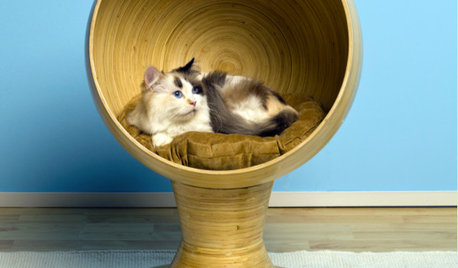anyone go thru CRF with elderly kitty?
tracey_b
15 years ago
Related Stories

LAUNDRY ROOMSThe Cure for Houzz Envy: Laundry Room Touches Anyone Can Do
Make fluffing and folding more enjoyable by borrowing these ideas from beautifully designed laundry rooms
Full Story
REMODELING GUIDESShould You Stay or Should You Go for a Remodel? 10 Points to Ponder
Consider these renovation realities to help you decide whether to budget for temporary housing
Full Story
SAVING WATERHouzz Call: Are You Letting Go of Your Lawn?
Many facing a drought are swapping turf for less thirsty plantings. If you’re one of them, we’d like to hear about it
Full Story
PETS12 Stylish Solutions for Ugly Cat Furniture
Bland beige post unhappily marking your living room territory? Scratch that with rakish kitty condos, perches and staircases
Full Story
DECORATING GUIDESHow to Savor Your Beautifully Imperfect Home
Hardly anyone escapes home design envy. These strategies can help you appreciate your home for all it offers you right now
Full Story
LIFERetirement Reinvention: Boomers Plot Their Next Big Move
Choosing a place to settle in for the golden years? You're not alone. Where boomers are going and what it might look like
Full Story
LIFE10 Steps for Saying Goodbye to Sentimental Objects
Are keepsakes cluttering your space and your life? Consider this approach for letting go and moving on
Full Story
HOLIDAYS10 Tips for a Calm, Heartfelt Thanksgiving
Go easy on yourself this year and allow some breathing room to enjoy the holiday
Full Story
UNIVERSAL DESIGN12 Must-Haves for Aging in Place
Design a home that will continue to be accessible, safe and stylish as the years go by
Full Story
REMODELING GUIDES8 Lessons on Renovating a House from Someone Who's Living It
So you think DIY remodeling is going to be fun? Here is one homeowner's list of what you may be getting yourself into
Full Story




petaloid
tracey_bOriginal Author
Related Discussions
feline, elderly, crf and possible uti and treatment???
Q
How does feline CRF progress?
Q
Now my other kitty is sick
Q
CRF question
Q
laurief_gw
Anne_Marie_Alb
lfnyc
laurief_gw
tracey_bOriginal Author
runsnwalken
tracey_bOriginal Author
laurief_gw
lfnyc
runsnwalken
laurief_gw
tracey_bOriginal Author
quasifish
laurief_gw
runsnwalken
tracey_bOriginal Author
laurief_gw
Anne_Marie_Alb
lfnyc
tracey_bOriginal Author
tracey_bOriginal Author
laurief_gw
runsnwalken
laurief_gw
laurief_gw
singleton165
quasifish
tracey_bOriginal Author
Elly_NJ
quasifish
tracey_bOriginal Author
lfnyc
tracey_bOriginal Author
laurief_gw
Anne_Marie_Alb
Elly_NJ
quasifish
tracey_bOriginal Author
laurief_gw
tracey_bOriginal Author
laurief_gw
tracey_bOriginal Author
laurief_gw